新概念英语第二册语法总结
- 格式:docx
- 大小:312.69 KB
- 文档页数:180
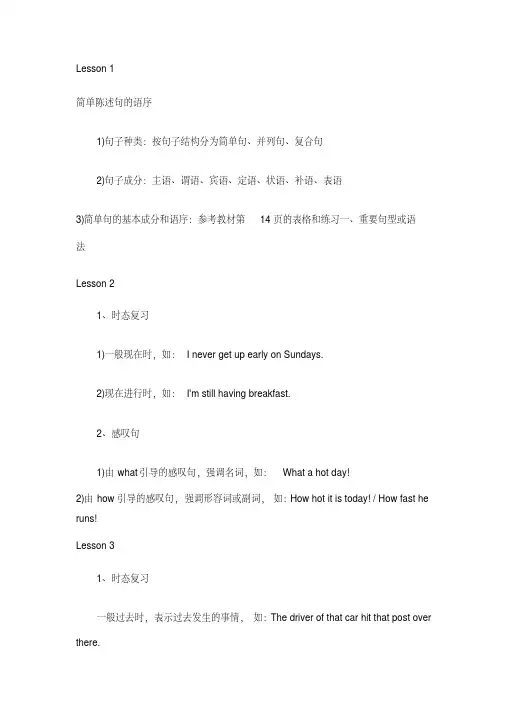
Lesson 1简单陈述句的语序1)句子种类:按句子结构分为简单句、并列句、复合句2)句子成分:主语、谓语、宾语、定语、状语、补语、表语3)简单句的基本成分和语序:参考教材第14页的表格和练习一、重要句型或语法Lesson 21、时态复习1)一般现在时,如:I never get up early on Sundays.2)现在进行时,如:I'm still having breakfast.2、感叹句1)由what引导的感叹句,强调名词,如:What a hot day!2)由how引导的感叹句,强调形容词或副词,如:How hot it is today! / How fast he runs!Lesson 31、时态复习一般过去时,表示过去发生的事情,如:The driver of that car hit that post over there.2、双宾动词1)双宾动词是指某些动词后面可以跟两个宾语,表物的为直接宾语,表人的为间接宾语。
2)注意区分双宾动词后间接宾语前用to还是for的区别,一般表示动作对某人而做用to,表示动作为某人而做用for。
如:He passed the salt to me. / She bought the tie for me.Lesson 4时态复习现在完成时,表示过去发生的事情对现在造成的影响或结果,如:I have seen the film.该句可能暗含的潜台词是:我对这部电影的情节比较了解了或者我不愿意再看这部电影了。
1)标志性词语:already/just/yet/never/ever2)常见时间状语:recently/lately;in the past/latest+一段时间;up to now/so far3)have been to(去过已回)与have gone to(去了未回)的区别4)瞬间动词(可用于完成时,但不能与一段时间连用)与持续动词的区别5)since(+具体时间/时间点)与for(+一段时间/时间段)的区别Lesson 51、时态复习1)一般过去时,表示过去发生的动作或状态,如:Yesterday, a pigeon carried the first message from Pinhurst to Silbury. / He was very tired after a whole day's work last night.2)现在完成时,表示过去发生的动作对现在造成的影响或结果,如:He has just bought another garage in Pinhurst. / In this way, he has begun his own private'telephone' service.2、有关way的短语1)in the way,表示挡路了或是按照某种方法/方式,如:The chair is in the way. / Do the job in the way your teacher has shown you.2)on the way,表示在路上,如:On the way home, I bought some cakes for my daughter.3)in this way,表示用这种方法,如:In this way, he has saved more than five thousand dollars.4)by the way,表示顺便说一下,如:By the way, have you seen Tom recently?5)in a way,表示在某种意义上,如:In a way, he is more than a teacher to us.Lesson 61、冠词的用法1)不定冠词a/an,如:a pen, an egg2)定冠词the,如:A dog is barking at me. The dog is black and white.3)零冠词,即不用冠词的情况,如人名和地名前面,如:John lives in London.2、短语动词的用法短语动词指的是后面跟上介词或副词后、意思会发生变化的动词。
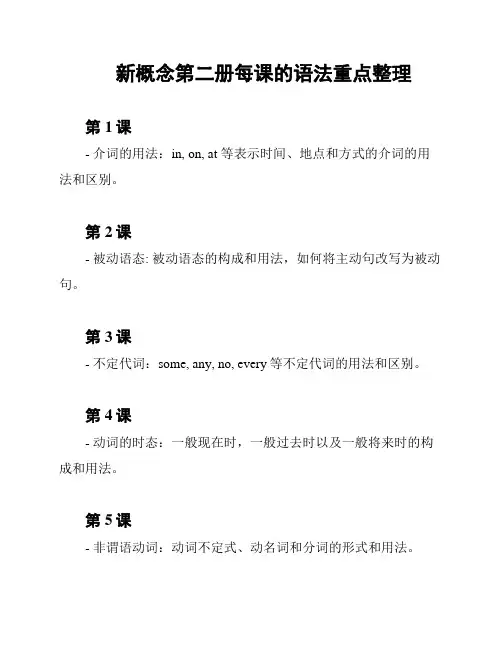
新概念第二册每课的语法重点整理第1课- 介词的用法:in, on, at 等表示时间、地点和方式的介词的用法和区别。
第2课- 被动语态: 被动语态的构成和用法,如何将主动句改写为被动句。
第3课- 不定代词:some, any, no, every等不定代词的用法和区别。
第4课- 动词的时态:一般现在时,一般过去时以及一般将来时的构成和用法。
第5课- 非谓语动词:动词不定式、动名词和分词的形式和用法。
第6课- 数量的表达:基数词和序数词,还有一些常见的数量词的用法。
第7课- 情态动词:can, could, may, might等情态动词的用法。
第8课- 连词的使用:and, but, or, so等连接词的用法和区别。
第9课- 名词的所有格:名词所有格的构成和用法,以及经典的名词所有格的错误用法。
第10课- 现在完成时:现在完成时的构成和用法,与一般过去时的区别。
第11课- 介词短语:介词短语作状语的用法和常见表达方式。
第12课- 虚拟语气:if条件句和虚拟语气的构成和用法。
第13课- 比较级和最高级:形容词和副词的比较级和最高级的构成和用法。
第14课- 状语从句:时间、地点、原因、条件等状语从句的引导词和用法。
第15课- 间接引语:直接引语和间接引语的转换和用法。
第16课- 冠词的使用:冠词a, an和the的用法和区别。
第17课- 时态的混合使用:不同时态的混合使用,如何表达不同的时间关系。
第18课- 直接引语:如何准确地引述他人的原文,注意引号和标点的使用。
第19课- 句型的使用:如何正确地使用倒装句、感叹句和祈使句。
第20课- 能愿动词:能愿动词的构成和用法,如何表达能力和意愿。
第21课- 主谓一致:主谓一致的原则和方法。
第22课- 介词的构成:介词形式的构成和用法,以及常见的介词短语。
第23课- 代词的使用:人称代词、物主代词和不定代词的用法和区别。
第24课- 婉转的表达:如何用委婉的方式表达意见、请求和建议。
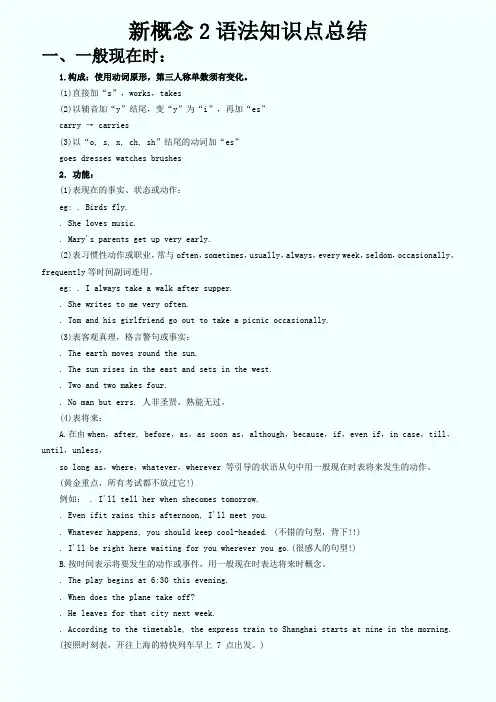
新概念2语法知识点总结一、一般现在时:1.构成:使用动词原形,第三人称单数须有变化。
(1)直接加“s”,works,takes(2)以辅音加“y”结尾,变“y”为“i”,再加“es”carry → carries(3)以“o, s, x, ch, sh”结尾的动词加“es”goes dresses watches brushes2.功能:(1)表现在的事实、状态或动作:eg: . Birds fly.. She loves music.. Mary's parents get up very early.(2)表习惯性动作或职业,常与often,sometimes,usually,always,every week,seldom,occasionally,frequently等时间副词连用。
eg: . I always take a walk after supper.. She writes to me very often.. Tom and his girlfriend go out to take a picnic occasionally.(3)表客观真理,格言警句或事实:. The earth moves round the sun.. The sun rises in the east and sets in the west.. Two and two makes four.. No man but errs. 人非圣贤,熟能无过。
(4)表将来:A.在由when,after, before,as,as soon as,although,because,if,even if,in case,till,until,unless,so long as,where,whatever,wherever 等引导的状语从句中用一般现在时表将来发生的动作。
(黄金重点,所有考试都不放过它!)例如: . I'll tell her when shecomes tomorrow.. Even ifit rains this afternoon, I'll meet you.. Whatever happens, you should keep cool-headed. (不错的句型,背下!!). I'll be right here waiting for you wherever you go.(很感人的句型!)B.按时间表示将要发生的动作或事件,用一般现在时表达将来时概念。
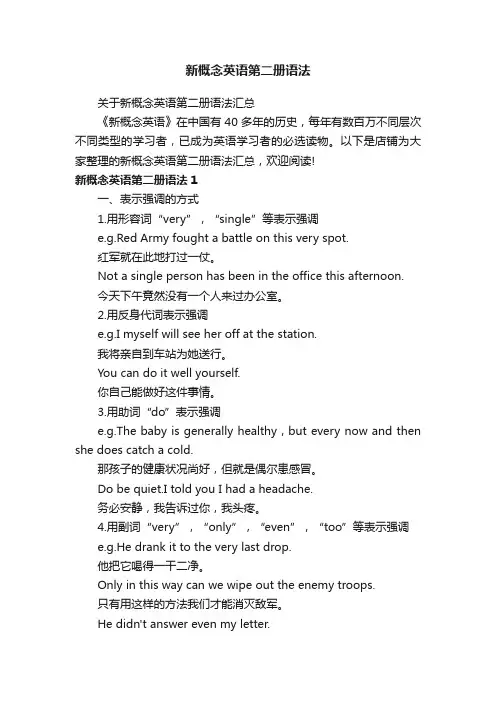
新概念英语第二册语法关于新概念英语第二册语法汇总《新概念英语》在中国有40多年的历史,每年有数百万不同层次不同类型的学习者,已成为英语学习者的必选读物。
以下是店铺为大家整理的新概念英语第二册语法汇总,欢迎阅读!新概念英语第二册语法1一、表示强调的方式1.用形容词“very”,“single”等表示强调e.g.Red Army fought a battle on this very spot.红军就在此地打过一仗。
Not a single person has been in the office this afternoon.今天下午竟然没有一个人来过办公室。
2.用反身代词表示强调e.g.I myself will see her off at the station.我将亲自到车站为她送行。
You can do it well yourself.你自己能做好这件事情。
3.用助词“do”表示强调e.g.The baby is generally healthy,but every now and then she does catch a cold.那孩子的健康状况尚好,但就是偶尔患感冒。
Do be quiet.I told you I had a headache.务必安静,我告诉过你,我头疼。
4.用副词“very”,“only”,“even”,“too”等表示强调e.g.He drank it to the very last drop.他把它喝得一干二净。
Only in this way can we wipe out the enemy troops.只有用这样的方法我们才能消灭敌军。
He didn't answer even my letter.他甚至连我的信都未回。
I will too go!我要去的!5.用“...and that”,“...and those”,“not...too much”,“否定加否定”等结构表示强调e.g.They fulfilled the task,and that in a few days.他们在几天内完成的就是那项任务。
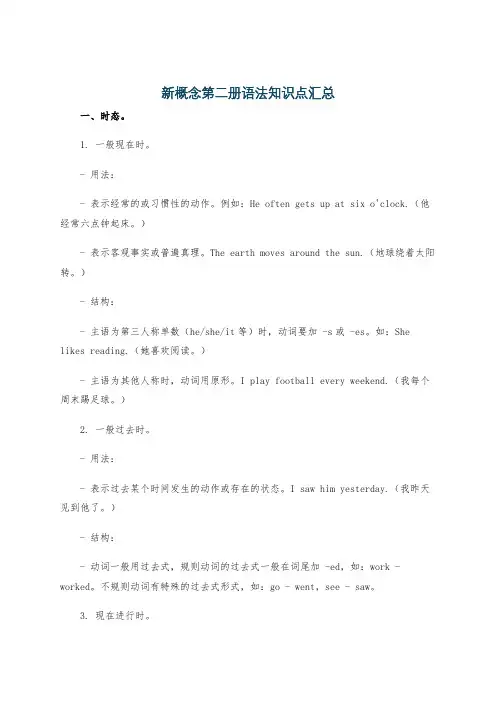
新概念第二册语法知识点汇总一、时态。
1. 一般现在时。
- 用法:- 表示经常的或习惯性的动作。
例如:He often gets up at six o'clock.(他经常六点钟起床。
)- 表示客观事实或普遍真理。
The earth moves around the sun.(地球绕着太阳转。
)- 结构:- 主语为第三人称单数(he/she/it等)时,动词要加 -s或 -es。
如:She likes reading.(她喜欢阅读。
)- 主语为其他人称时,动词用原形。
I play football every weekend.(我每个周末踢足球。
)2. 一般过去时。
- 用法:- 表示过去某个时间发生的动作或存在的状态。
I saw him yesterday.(我昨天见到他了。
)- 结构:- 动词一般用过去式,规则动词的过去式一般在词尾加 -ed,如:work - worked。
不规则动词有特殊的过去式形式,如:go - went,see - saw。
3. 现在进行时。
- 表示现在正在进行的动作。
Look! She is dancing.(看!她正在跳舞。
)- 结构:- be动词(am/is/are)+动词的 -ing形式。
He is reading a book.(他正在读一本书。
)4. 过去进行时。
- 用法:- 表示过去某个时刻或某段时间正在进行的动作。
At that time yesterday, I was doing my homework.(昨天那个时候,我正在做家庭作业。
)- 结构:- was/were+动词的 -ing形式。
They were playing football at threeo'clock yesterday afternoon.(他们昨天下午三点正在踢足球。
)5. 现在完成时。
- 用法:- 表示过去发生的动作对现在造成的影响或结果。
I have lost my key.(我把钥匙丢了。
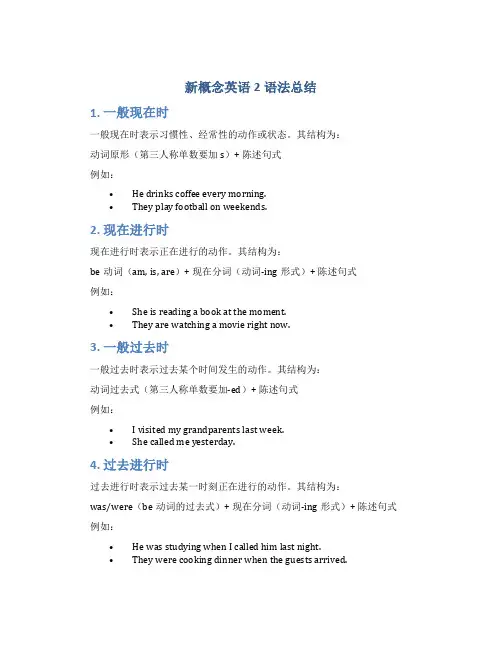
新概念英语2语法总结1. 一般现在时一般现在时表示习惯性、经常性的动作或状态。
其结构为:动词原形(第三人称单数要加s)+ 陈述句式例如:•He drinks coffee every morning.•They play football on weekends.2. 现在进行时现在进行时表示正在进行的动作。
其结构为:be动词(am, is, are)+ 现在分词(动词-ing形式)+ 陈述句式例如:•She is reading a book at the moment.•They are watching a movie right now.3. 一般过去时一般过去时表示过去某个时间发生的动作。
其结构为:动词过去式(第三人称单数要加-ed)+ 陈述句式例如:•I visited my grandparents last week.•She called me yesterday.4. 过去进行时过去进行时表示过去某一时刻正在进行的动作。
其结构为:was/were(be动词的过去式)+ 现在分词(动词-ing形式)+ 陈述句式例如:•He was studying when I called him last night.•They were cooking dinner when the guests arrived.5. 一般将来时一般将来时表示将来某个时间会发生的动作或状态。
其结构为:will/shall(情态动词)+ 动词原形 + 陈述句式例如:•I will visit my friend next week.•He will cook dinner tonight.6. 现在完成时现在完成时表示过去某个时间范围内发生的动作,且与现在有关。
其结构为:have/has(情态动词)+ 过去分词(动词的第三态)+ 陈述句式例如:•She has finished her homework.•They have watched that movie.7. 过去完成时过去完成时表示过去某个时间点之前已经发生的动作或状态。
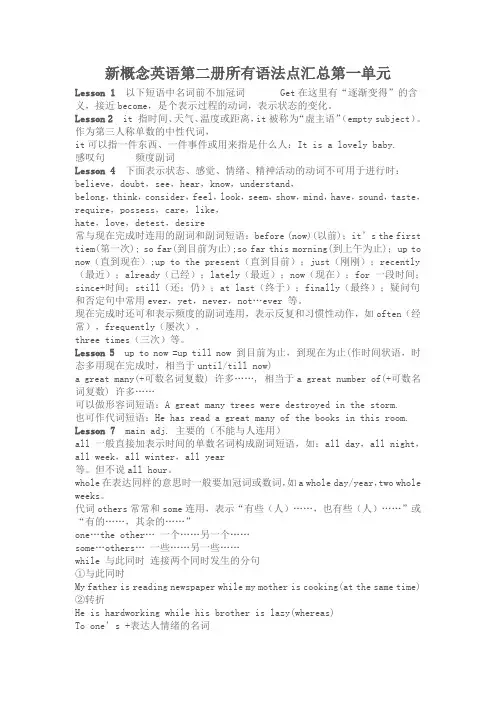
新概念英语第二册所有语法点汇总第一单元Lesson 1 以下短语中名词前不加冠词Get在这里有“逐渐变得”的含义,接近become,是个表示过程的动词,表示状态的变化。
Lesson 2 it 指时间、天气、温度或距离,it被称为“虚主语”(empty subject)。
作为第三人称单数的中性代词,it可以指一件东西、一件事件或用来指是什么人:It is a lovely baby.感叹句频度副词Lesson 4 下面表示状态、感觉、情绪、精神活动的动词不可用于进行时:believe,doubt,see,hear,know,understand,belong,think,consider,feel,look,seem,show,mind,have,sound,taste,require,possess,care,like,hate,love,detest,desire常与现在完成时连用的副词和副词短语:before (now)(以前);it’s the first tiem(第一次); so far(到目前为止);so far this morning(到上午为止);up to now(直到现在);up to the present(直到目前);just(刚刚);recently (最近);already(已经);lately(最近);now(现在);for 一段时间;since+时间;still(还;仍);at last(终于);finally(最终);疑问句和否定句中常用ever,yet,never,not…ever 等。
现在完成时还可和表示频度的副词连用,表示反复和习惯性动作,如often(经常),frequently(屡次),three times(三次)等。
Lesson 5 up to now =up till now 到目前为止,到现在为止(作时间状语,时态多用现在完成时,相当于until/till now)a great many(+可数名词复数) 许多……, 相当于a great number of(+可数名词复数) 许多……可以做形容词短语:A great many trees were destroyed in the storm.也可作代词短语:He has read a great many of the books in this room. Lesson 7 main adj. 主要的(不能与人连用)all 一般直接加表示时间的单数名词构成副词短语,如:all day,all night,all week,all winter,all year等。
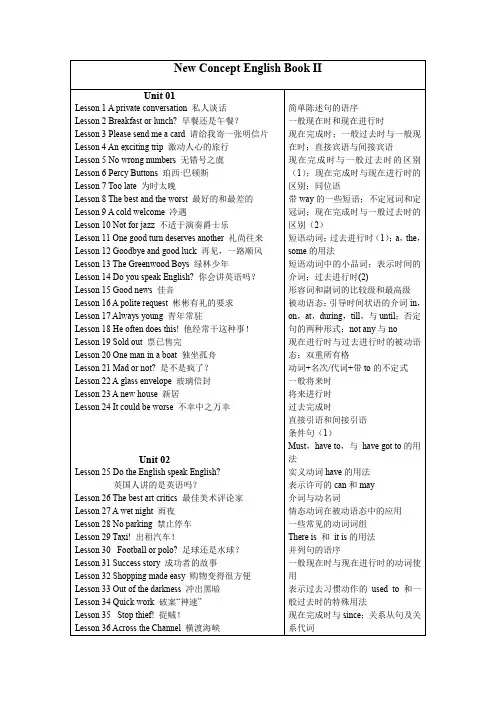
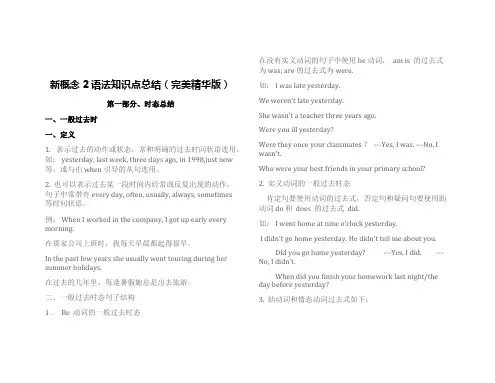
新概念2语法知识点总结(完美精华版)第一部分、时态总结一、一般过去时一、定义1. 表示过去的动作或状态,常和明确的过去时间状语连用,如: yesterday, last week, three days ago, in 1998,just now 等,或与由 when 引导的从句连用。
2. 也可以表示过去某一段时间内经常或反复出现的动作。
句子中常带有 every day, often, usually, always, sometimes等时间状语。
例: When I worked in the company, I got up early every morning.在那家公司上班时,我每天早晨都起得很早。
In the past few years she usually went touring during her summer holidays.在过去的几年里,每逢暑假她总是出去旅游。
二、一般过去时态句子结构1 . Be 动词的一般过去时态在没有实义动词的句子中使用 be 动词, am is 的过去式为 was; are 的过去式为 were.如: I was late yesterday.We weren't late yesterday.She wasn't a teacher three years ago.Were you ill yesterday?Were they once your classmates ? ---Yes, I was. ---No, I wasn't.Who were your best friends in your primary school?2. 实义动词的一般过去时态肯定句要使用动词的过去式,否定句和疑问句要使用助动词 do 和 does 的过去式 did.如: I went home at nine o'clock yesterday.I didn't go home yesterday. He didn't tell me about you.Did you go home yesterday? ---Yes, I did. ---No, I didn't.When did you finish your homework last night/the day before yesterday?3. 助动词和情态动词过去式如下:shall ― should (将要)用于第一人称单数will ― would (将要)用于所有人称can ― could (能,会)may ― might (可以)must ― must (必须) have to ― had to (不得不)助动词和情态动词的过去时态要使用他们的过去式,后面的动词还使用原形。
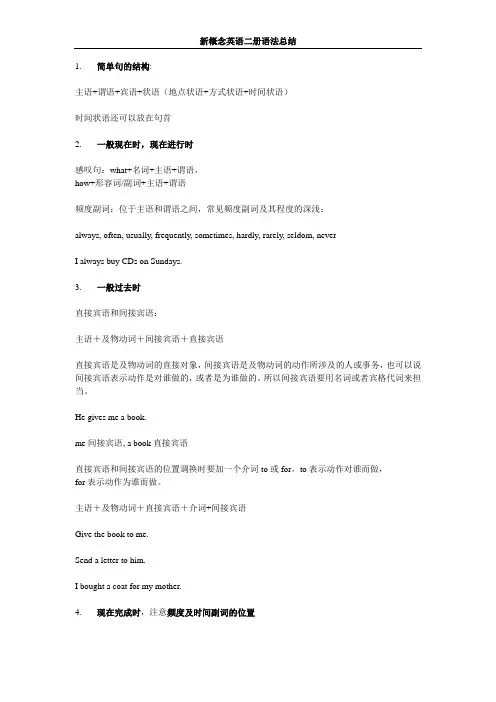
1. 简单句的结构:主语+谓语+宾语+状语(地点状语+方式状语+时间状语)时间状语还可以放在句首2. 一般现在时,现在进行时感叹句:what+名词+主语+谓语,how+形容词/副词+主语+谓语频度副词:位于主语和谓语之间,常见频度副词及其程度的深浅:always, often, usually, frequently, sometimes, hardly, rarely, seldom, neverI always buy CDs on Sundays.3. 一般过去时直接宾语和间接宾语:主语+及物动词+间接宾语+直接宾语直接宾语是及物动词的直接对象,间接宾语是及物动词的动作所涉及的人或事务,也可以说间接宾语表示动作是对谁做的,或者是为谁做的。
所以间接宾语要用名词或者宾格代词来担当。
He gives me a book.me间接宾语, a book直接宾语直接宾语和间接宾语的位置调换时要加一个介词to或for,to表示动作对谁而做,for表示动作为谁而做。
主语+及物动词+直接宾语+介词+间接宾语Give the book to me.Send a letter to him.I bought a coat for my mother.4. 现在完成时,注意频度及时间副词的位置receive/take5. 复习:一般过去时与现在完成时的区别in the way/on the way/in this way/by the way/in a way/get out of my way/Don’t stand in my way./ by the way/no wayspare/to spare6. 冠词用法(一)1).不定冠词用于修饰单数可数名词,当一个单词的第一个发音为元音时要用冠词an, 如果是辅音用a即可。
2).不定冠词还可以用来修饰一类事物,有时候也可以省略:A cat is a lovely animal. Cat is a lovely animal.3).不可数名词加冠词表示一类事物:Apple is a fruit.4).如果特制某人,某物或上文提过的人或物时要用定冠词the5). Some表示一些,可以修饰可数名词及不可数名词。
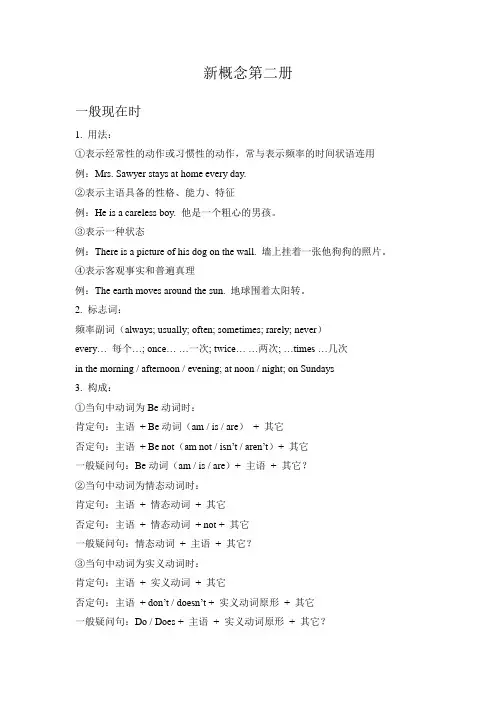
新概念第二册一般现在时1. 用法:①表示经常性的动作或习惯性的动作,常与表示频率的时间状语连用例:Mrs. Sawyer stays at home every day.②表示主语具备的性格、能力、特征例:He is a careless boy. 他是一个粗心的男孩。
③表示一种状态例:There is a picture of his dog on the wall. 墙上挂着一张他狗狗的照片。
④表示客观事实和普遍真理例:The earth moves around the sun. 地球围着太阳转。
2. 标志词:频率副词(always; usually; often; sometimes; rarely; never)every… 每个…; once… …一次; twice… …两次; …times …几次in the morning / afternoon / evening; at noon / night; on Sundays3. 构成:①当句中动词为Be动词时:肯定句:主语+ Be动词(am / is / are)+ 其它否定句:主语+ Be not(am not / isn’t / aren’t)+ 其它一般疑问句:Be动词(am / is / are)+ 主语+ 其它?②当句中动词为情态动词时:肯定句:主语+ 情态动词+ 其它否定句:主语+ 情态动词+ not + 其它一般疑问句:情态动词+ 主语+ 其它?③当句中动词为实义动词时:肯定句:主语+ 实义动词+ 其它否定句:主语+ don’t / doesn’t + 实义动词原形+ 其它一般疑问句:Do / Does + 主语+ 实义动词原形+ 其它?●特别注意:一般现在时,当主语为第三人称单数时,实义动词变其三单形式。
do和does为一般现在时的助动词,在否定句及疑问句中辅助实义动词使用,当句中有助动词do和does时,实义动词变原形(吸星大法/ 照妖镜)。
L.1 1.五大基本句型2.零冠词精讲背诵L.2 1.现在进行时与一般现在2.感叹句的基本结构精讲L.3 1.“给予”动词带双宾精讲背诵L.41.现在完成2.Accept vs.receive3.excited vs. exciting知识点和第五课重复,可以不讲L.5 1.一般现在时与过去完成时的区2.In 3 minutes vs. in 3 minutes’ time3. 带way的短语精讲课文:背诵课文L.6 1.in vs.on2.不定冠词的一般用法3 动词词组搭配精讲课文:背诵L.7 1.expect的用2.过去进行3.When, while and as4. 小品词(副词vs介词)精讲L.8 1.形容词和副词的比较级和最高2.谓语动词的单复数确定精讲:背诵L.9 1.基本时间介词的用法:at, in, on, during, through, till, until2 时间表示法次精讲L.10 1.被动语2.名词所有格,双重所有格(37)3.made in, made of, made from, made by 精讲;鼓励背诵,加强语感L.11 1.deserve的用2.不定式作宾语动词后是否需要先加一个名词或代词次精讲:适合背诵L.121.一般将来时可以不讲L.13 1.将来进行时和一般将来时的区别精讲L.141.Except, except for, apart from次精讲L.15 1.afford的用法2.interrupt的用3.直接引语与间接引语精讲:背诵L.161.Remind的用2.Fail的用3.if条件句精讲:背诵L.17 1.in spite of2.介词的用法in, 3 情态动词精讲:鼓励背诵L.18 1.have的多种用法(助动词,完全动词2.关于give的词组自学课文L.19 1.hurry的用2.Can vs may; can vs could; may vs might3. might as well次精讲:设置场景,组对背诵L.20 1.动名词充当主语和宾2.Instead of vs. instead精讲:背诵L.21 1.含助动词的被动语2.Come into3.drive的不同用4.Home vs. house次精讲L.22 1 课后介词搭配练习文章次精讲L.23 1.there is vs. it is自学课文L.24 1 复习,主要是课后练习次精讲:鼓励背诵L.25 1 并列句选择or/either…or…/neither…nor…反意but/yet 推论so/thus原因for精讲:背诵L.26 1.pretend的用2.Appreciate的用3.Hang的用4.哪些动词不适用于进行时次精讲:鼓励组对背诵L.27 1.关于put的词组2 and 引导的并列句次精讲L.28 1.现在完成时(现在完成时+since/ever since; 最高级句+现在完成时;have been to vs. have gone to)2 it is one of the ugliest faces I have ever seen次精讲:现在完成时L.29 1 called 初步引导定语从句省略2 the most surprising thing about it isthat …表语从句精讲:背诵课文L.30 1.towards的用2.定冠词的用法3 there were some people doing sth. 4 so…that…次精讲L.31 ed to do/be used to/get used to 2 过去完成时,过去进行时精讲课文:鼓励背诵,加强语感L.321.形容词同级比较(as…as),than usual 2 一段时间之后,发生另外一件事。
新概念英语第二册语法总结新概念英语第二册语法总结:将来完成时将来完成时:1.构成:shall/will have+过去分词2.功能:表示将来某时之前已经完成的动作。
►.They will have been here for 5 years next Friday►.By the end of next term,the students will have finished the book.过去将来完成时:1.构成:would/should have+过去分词2.功能:表示从过去某个时间看将来某时之前已经完成的动作。
►.He said that they would have arrived by seven o'clock.将来完成进行时:1.构成:shall/will have been+现在分2.功能:表示某一动作将继续到将来某时,且该动作此时尚未发生。
►.We shall have been staying here for four weeks when Tom arrives.►.It will have been raining for a week if it does not stop tomorrow.测试精编(综合训练)1.Simple photographic lenses can't________sharp,undistorted images over a wide field.A.to formB.are formedC.formingD.form2.Of all the factors affecting agricultural yields,weather is the one________the most.A.it influences farmersB.that influences farmersC.farmers that it influencesD.why farmers influence it3.By tracking the eye of a hurricane,forecasters can determine the speed at which______.A.is a storm movingB.a storm is movingC.is moving a stormD.a moving storm4.During the flood of 1927,the Red Cross,________out of emergency headquarters in Mississippi,set u p temporary shelters for the homeless.A.operates B.is operating C.has operated D.operating5.Of all the economically important plants,palms have been________.A.the least studiedB.study the leastC.study less and lessD.to study the less6.During an eclipse of the sun,________in the shadow of the Moon.A.the Earth liesB.the Earth when lyingC.that the Earth liesD.the lying Earth7.The photo periodic response of algae actually depends on the duration of darkness,___.A.the light is not onB.and not on lightC.but is not on the lightD.is not on light8.The wallflower_____because its weak stems often grow on walls and along strong cliffs for support.A.so called isB.so is calledC.is so calledD.called is so9.Because of its importance in modern living,________in all parts of the world.A.algebra is studied in schools and collegesB.studying algebra in schools and collegesC.and the study of algebra in schools and collegesD.in schools and colleges are algebra studies10.Sociologists have long recognized that social tension________.A.elements from group livingB.elements of a normal group lifeC.living are a group of elementsD.a re normal elements of group lifeKEYS1.D 2.B 3.B 4.D 5.A 6.A 7.B 8.C 9.A 10.D新概念英语第二册语法总结:现在完成时现在完成时:1.构成:have/has+过去分词2.功能:(1)表示过去所发生的动作对现在的影响或产生的结果。
1.五大基本句型2.零冠精背1.在行与一般在2.感句的基本构精1.“ 予” 双精背1.在达成 2. Accept vs. exciting 知点和第五重复,能够不1.一般在与去达成的区 2.In 3 minutes vs. in 3 minutes’ time3. way 的短精文:背文.不定冠的一般用法 3 搭配精文:背的用法 2.去行 3.When, while and as4. 小品(副 vs 介)精1.形容和副的比和最高2.的复数确立精:背1.基本介的用法: at, in, on, during, through, till, until2表示法次精1.被2.名全部格,两重全部格(37)in, made of, made from, made by 精 ;鼓舞背,加感的用法 2.不定式作后能否需要先加一个名或代次精:合适背1.一般未来能够不1.未来行和一般未来的区精1. Except, except for, apart from 次精的用法的用法 3.直接引与接引精:背1. Remind 的用法 2.Fail 的用法 3.if 条件句精:背spite of2.介的用法 in, 3 情精:鼓舞背L.18 的多种用法(助,完整)2.对于 give 的自学文L.19 的用法 2.Can vs may; can vs could; may vs might3. might as well次精:置景,背1.名充任主和2.Instead of vs. instead 精:背1.含助的被2.Come 的不一样用法 4. Home vs. house次精1 后介搭配文章次精is vs. it is自学文1复,主假如后次精:鼓舞背1 并列句or/either ⋯ or⋯/neither ⋯ nor⋯反意but/yet推so/thus原由for精:背的用法 2.Appreciate 的用法 3.Hang 的用法 4.哪些不合用于行次精:鼓舞背1.对于 put 的 2 and 引的并列句次精1.在达成(在达成 +since/ever since; 最高句 +在达成;have been to vs. have gone to)2 it is one of the ugliest faces I have ever seen次精:在达成1 called 初步引定从句省略2 the most surprising thing about it is that ⋯表从句精:背文的用法 2.定冠的用法 3 there were some people doing sth. 4 so⋯ that ⋯次精to do/be used to/get used to 2去达成,去行精文:鼓舞背,加感1.形容同比( as⋯ as), than usual 2 一段以后,生此外一件事。
最全的新概念英语第二册语法汇总一、基础语法1. 简单现在时:描述经常性、惯性或普遍性的动作或状态。
如:I go to school every day.2. 简单过去时:描述过去发生的动作或状态。
如:He visitedhis grandparents last weekend.3. 简单将来时:描述将来要发生的动作或状态。
如:We will have a party next week.4. 现在进行时:描述目前正在进行的动作。
如:She is studying for her exam.5. 过去进行时:描述过去某个时间点正在进行的动作。
如:They were playing soccer yesterday afternoon.6. 将来进行时:描述将来某个时间将会进行的动作。
如:I will be working late tonight.二、进阶语法1. 被动语态:表示动作的承受者在句中更重要。
如:The book was written by him.2. 间接引语:重述别人说的话,常常使用动词say、tell等。
如:He said that he was tired.3. 定语从句:用来修饰名词,常以关系代词who、which、that引导。
如:The man who is talking to Mary is my uncle.4. 倒装句:将句子的主语和谓语动词的位置颠倒。
如:Only by working hard can you achieve success.5. 条件句:表示假设、条件或可能性,分为三种类型。
如:If I have time, I will go to the party.6. 反意疑问句:通常由一个肯定句和一个否定短语组成。
如:You like coffee, don't you?三、高级语法2. 主语从句:作为句子的主语,由连词that引导。
新概念英语第二册语法总结Revised as of 23 November 2020《新概念英语第二册》语法总结知识要点:冠词是一种虚词,放在名词的前面,帮助说明名词的含义。
冠词分不定冠词(The Indefinite Article)和定冠词(The definite Article)两种。
a (an) 是不定冠词,a用在辅音之前:如a book, a man; an用在元音之前,如:an old man, an hour, an interesting book等。
the是定冠词。
一、不定冠词的用法1、指人或事物的某一种类(泛指)。
这是不定冠词a (an)的基本用法。
如:She is a girl. I am a teacher. Please pass me an apple.2、指某人或某物,但不具体说明何人或何物。
如:He borrowed a story-book from the library.A Wang is looking for you. 一位姓王的同志正在找你。
3、表示数量,有“一”的意思,但数的概念没有one强烈。
如:I have a mouth, a nose and two eyes.4、用于某些固定词组中。
如:a bit, a few, a little, a lot of, a piece of, a cup of, a glass of, a pile of, a pair of, have a good time, for a while, for a long time等。
5、用在抽象名词前,表具体的介绍——a + 抽象名词,起具体化的作用。
如:This little girl is a joy to her parents. 这女孩对她父母来说是一个乐趣。
It is a pleasure to talk with you. 跟您交谈真是一件愉快的事情。
It is an honour to me to attend the meeting. 参加这个会,对我来说是一种荣誉。
二、定冠词的用法:1、特指某(些)人或某(些)事物。
这是定冠词the的基本用法。
如:Beijing is the capital of China.The pen on the desk is mine.2、指谈话双方都知道的人或事物。
如:Where is the teacherOpen the window, please.3、指上文提过的人或事物(第二次出现)。
如:There was a chair by the window. On the chair sat a young woman with a baby in her arms. The baby was thin.4、用在世界上独一无二的事物前。
如:the earth, the moon, the sun.5、用在序数词和形容词最高级前。
(副词最高级前的定冠词可省略)如:He is always the first to come to school.Bob is the tallest in his class.6、用在某些专有名词前(由普通名词构成的专用名词)。
如:the Great Wall, the Summer Palace, the Science Museum, the Childr en’s Palace, the Party等。
7、用在一些习惯用语中。
如:on the day, in the morning (afternoon, evening), the day after tomorrow, the day before yesterday, the next year, by the way等。
8、用在江河湖海、山脉前。
如:the Yellow River, the Pacific Ocean, the Alps, the Himalayas9、用在报刊、杂志前。
如:t he People’s Daily, the Evening Paper, the Times 泰晤士报。
10、表示某一家人要加定冠词。
如:The Browns are at home to receive visitors today. 布朗一家今天要接待客人。
11、用在形容词前,表某一类人。
如:the poor, the wounded, the living, the dead, the rich, the sick等。
12、定冠词可以表示一事物内部的某处。
如:The driver always sits in the front of the bus(car).三、零冠词(即不用冠词):1、专用名词和不可数名词前。
如:China, America, Grade One, Class Two, milk, oil, water, paper, science等。
2、名词前已有作定语用的this, that, my, your, some, any等代词。
如:Go down this street.3、复数名词表示一类人或事物时。
如:We are students. I like reading stories.4、节日、日期、月份、季节前。
如:Teachers’ Day, Children’s Day, National Day, in summer, in July等。
Today is New Year’s Day. It is Sunday. March 8 is Women’s Day.5、在称呼语或表示头衔的名词前,尤其作表语、宾补时。
如:What’s the matter, Granny We elected him mo nitor.6、在某些习惯用语中的名词前。
如:at noon, at night, at first, at last, at most, at least, by bus(train, air, sea), in bed, in time, in front of, go to school, go to bed, go to college, on foot, at table, in ink, in pencil等。
7、在三餐饭和球类运动前。
如:She goes to school after breakfast every morning.We are going to play football.We usually have lunch at school.8、科目前不加。
如:We learn Chinese, maths, English and some other subjects.【专项训练】:1、We can’t live without air.A.an B.×C.the D.some 2、——Have you seen pen I left it here this morning.——Is it black one I think I saw it somewhere.A.a; the B.the; the C.the; a D.a; a3、I’ve been waiting for him for hour and half.A.×; ×B.the; a C.a; the D.an; a4、What fine weather we have today!A.a B.×C.some D.an5、Have you ever seen as tall as this oneA.a tree B.such tree C.an tree D.tree6、Children usually go to school at age of six.A.×; the B.a; an C.the; ×D.the; the7、Himalayas is highest mountain in world.A.×; the;×B.The; the; the C.A; a; a D.×;×;×8、They each have __book. Li Hua’s is about writer. Wang Lin’s is on science.A.a; a; ×B.the; ×; the C.×; the; ×D.a; the; a9、Physics is science of matter and energy.A.The; ×B.×; ×C.×; the D.A; a10、sun rises in east and sets in west.A.A; an; a B.The;×;×C.The; the; the D.A; the; a11、Many people agree that__knowledge of English is a must in international trade today.A.a;×B.the; an C.the; the D.×; the 12、__Mr Jones called while you were out (neither of us knows this man). He was inbadtemper. A.×;a B.A;×C.The; the D.A; a 13、They were at dinner then. It was delicous one.A.a; the B.×;×C.×;a D.a; a14、what kind of car do you want to buyA.×B.the C.a D.an15、Alice is fond of playing piano while Henry is interested in listening to music.A.×; the B.×;×C.the; ×D.the; the16、Beyond stars, the astronaut saw nothing but space.A.the; ×B.×; the C.×;×D.the; the17、Alexander Graham Bell invented telephone in 1876.A.×B.a C.the D.one 18、——Where’s Jack——I think he’s still in bed, but he might just be in bathroom.A.×;×B.the; the C.the; ×D.×; the19、Many people are still in habit of writing silly things in public places.A.the; the B.×;×C.the; ×D.×; the 20、——I’d like information about the management of your hotel, please.——Well, you could have word with the manager. He might be helpful.A.some; a B.an; some C.some; some D.an; a【答案】:1、B air是不可数名词。